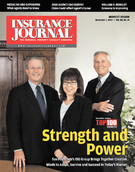Always Exceptional
“It’s easy to forget the good times during times of adversity, but we need to remember that our unique experiment with democracy has produced greater prosperity for more people than any other system in the history of civilization.”
—David A. Sampson, president and CEO of the Property Casualty Insurers Association of America (PCI). At PCI’s recent annual meeting, Sampson told insurance CEOs and senior executives that America faces a struggle between two competing visions for the future – a choice between a free market system and an expanded federal government. The association leader encouraged the conference attendees to be “cautiously optimistic as America is a hopeful nation.” Sampson said that despite the widespread private sector anxiety over America’s future, the weak economic recovery, and the policy uncertainties out of Washington, America has always been exceptional.
Weighty Problems
“It’s hard to find conditions that aren’t worsened or made more expensive by obesity.”
—John Cawley, an associate professor of policy analysis and management at Cornell University. Nearly 17 percent of U.S. medical costs can be blamed on obesity, according to new research that suggests the nation’s weight problem may be having close to twice the impact on medical spending as previously estimated. The research by Cawley and Chad Meyerhoefer of Lehigh University placed obesity-related medical costs at around $168 billion. The study released by the National Bureau of Economic Research, a nonprofit, nonpartisan research organization, contradicts a previous study that estimated obesity-related medical costs at $147 billion, or about 9 percent of total medical costs. The earlier study estimated that obesity adds about $1,400 to a person’s annual medical bills. The new study suggests the added cost is double that, exceeding $2,800.
More Buckling Up
“This survey points to the continuing success of the primary seat belt law and more importantly, tells us more Minnesota motorists have a greater chance of surviving a crash. … The challenge remains to change the behavior of that last portion of motorists who neglect to buckle up and remain at risk.”
—Cheri Marti, director of the Minnesota Department of Public Safety Office of Traffic Safety, says a study shows seatbelt use during daytime hours in that state has increased to 92 percent from a previous record of 90 percent in 2009. Daytime belt use was at 73 percent a decade ago and has steadily climbed. DPS officials say awareness, education and enforcement of the primary seat belt law, effective since June 9, 2009, helped push compliance above the 90 percent-mark for two consecutive years. DPS reports motor vehicle occupant deaths were down 7 percent in 2009 compared to 2008 (pre-primary belt law). The law requires drivers and all passengers, including in the back seat, to be buckled up or in the correct child restraint.
Was this article valuable?
Here are more articles you may enjoy.


 Aon Adds to List of Brokers Suing Howden US for Alleged Poaching, Theft
Aon Adds to List of Brokers Suing Howden US for Alleged Poaching, Theft  Former CEO of Nonprofit P/C Statistical Agent Sentenced for Stealing Millions
Former CEO of Nonprofit P/C Statistical Agent Sentenced for Stealing Millions  Louvre Tightens Security After $102M Jewel Heist, Installs Bars on Infamous Window
Louvre Tightens Security After $102M Jewel Heist, Installs Bars on Infamous Window  Three Top P/C Insurers Account for Most of Insurance AI Patents
Three Top P/C Insurers Account for Most of Insurance AI Patents 


